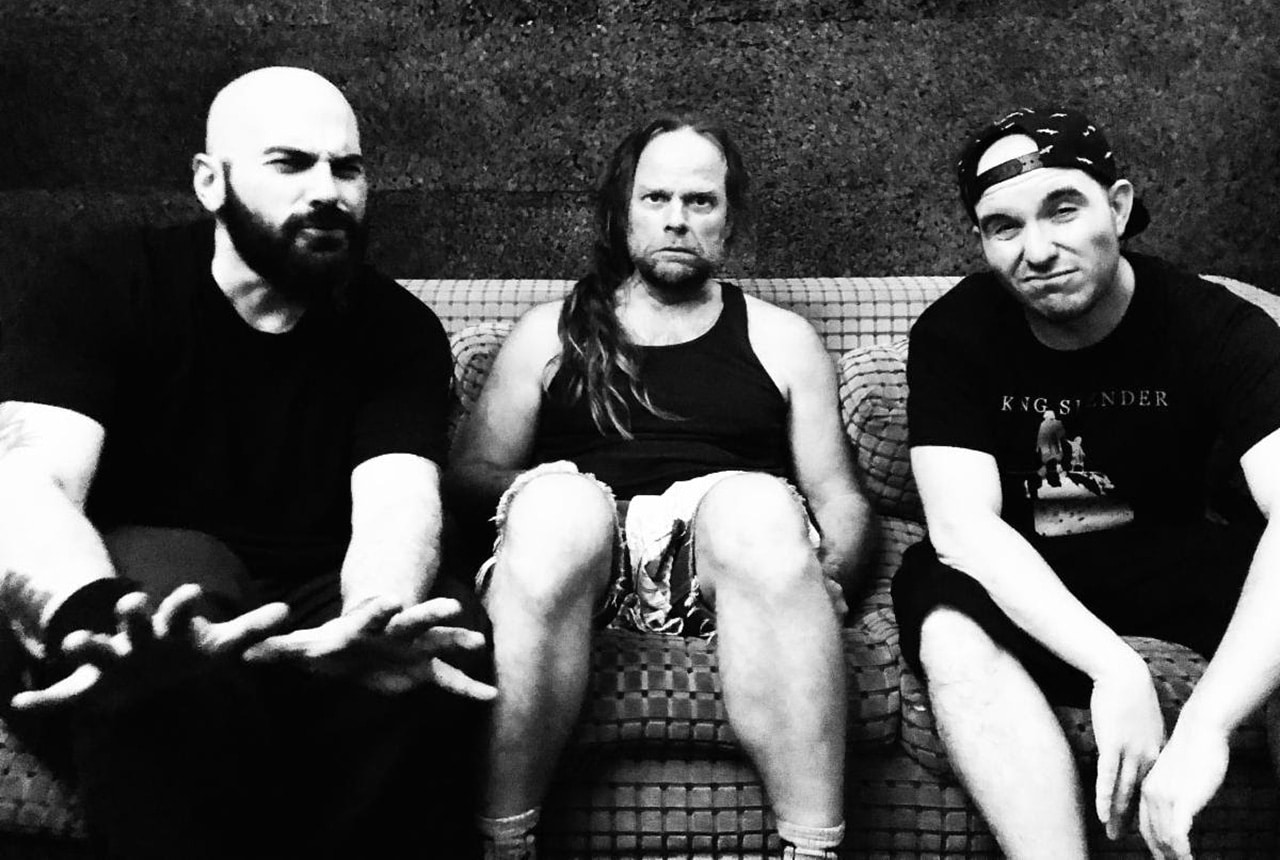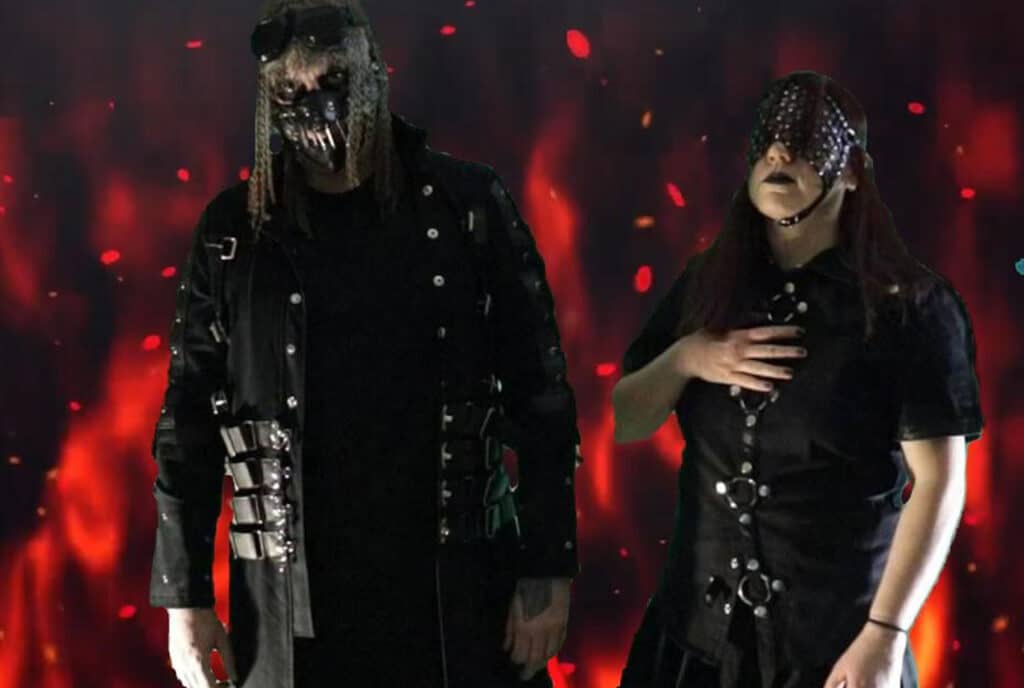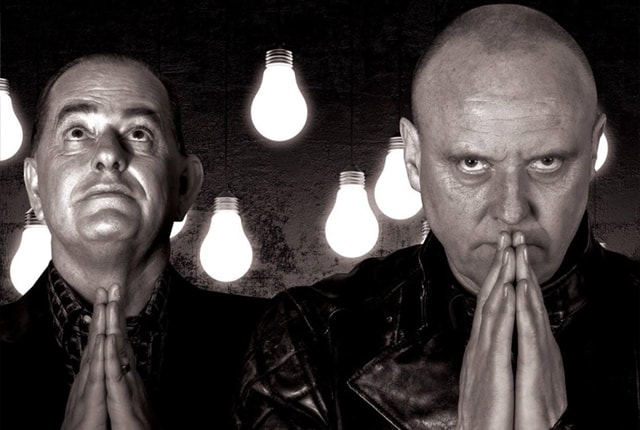For their seventh album, Mjölnir, experimental rock band Cinema Cinema continued to embrace improvisation, but this time with a new collaborator. Brooklyn-born cousins Ev Gold (vocals/guitar) and Paul Claro (drums) teamed up with Thor Harris (Thor & Friends, Shearwater, Swans, Xiu Xiu, etc.) for a spontaneous recording session that was then edited down and shaped into the eight tracks that appear on the release. The recording took place at BC Studio, run by Martin Bisi. Both the studio itself and Bisi’s extensive past work with Cinema Cinema were significant influences on the project.
Over Zoom, Claro discussed working with Thor and the process of making Mjölnir.
For this album, you collaborated with Thor Harris. Could you talk about how this collaboration came about?
Paul Claro: It’s a bit of a long story. Cinema Cinema has been together for 15 years, and around 2010 recorded an album with Don Zientara. That was our album that came out in 2012, which is called Manic Children and the Slow Aggression. Don Zientara did a lot of the Fugazi albums, and has Inner Ear [Studios] in DC. So, through that time working with Don, that’s how we came into touch with Howard. And Howard’s been our publicist ever since. Don introduced us, and ultimately, Howard has a lot of connections and famous artists that he works with.
And one of those artists was Swans. We were just excited that we were on the same roster as anything related to Swans, and some of the other artists that Howard works with. We were never really thinking that we would cross paths with any of those people in any capacity. It just so happened that Thor was with Swans for a number of years. I think throughout the time of being on the roster that Howard represents, we knew that Thor was involved with Swans, and we knew that there was a connection there, and we kind of connected with Thor on Twitter. Through the years it was always kind of just, he knew about us and we knew about him, obviously.
Howard kind of kept watering that flower. And eventually, it just so happened that Thor was coming to Brooklyn and we were just like, “Hey, if you’re coming to Brooklyn, do you want to record, if we can?” Me and Ev, we both have normal day jobs and we just cleared our schedule and took the day off. Thor was free one afternoon, and he just kind of came in and we recorded the album just like that. Just basically from meeting him, saying hi, he came into the studio, basically arms swinging with no instruments or anything. We just cobbled together kind of an amalgamation of whatever we had in the studio. He just kind of came in… and I think it was the opportunity to record this specific studio that we record in Brooklyn, BC Studio with Martin Bisi, who worked with Sonic Youth and a number of acts. So, basically Thor kind of just showed up. We made a setup for him. He had some drum stuff. I had a couple of pieces that I lent him, and then also there was some synth stuff that he set up, and he had this little musical situation set up. And we just hit record and shook hands and started playing, you know, basically. And, in a small microcosm, that’s how it all kind of came to be.
Was any prep work done in advance, in terms of having some musical ideas ready to bring into it?
Paul Claro: Me and Ev, we do a lot of practicing, obviously, and we have a lot of jamming, and there are little motifs and things, and ideas that perhaps we had and we thought, “Oh, you know, when we sit down with Thor, we’ll show him these things and we’ll say, you know, let’s try to work off of this idea.” And we had kind of maybe like three or four at most ideas or motifs that we thought, like riffs or something that maybe we can expand on with Thor when we got down to it. But I think by the time it was getting close to actually recording with Thor – and for Thor to come down to Brooklyn – we kind of got rid of that idea and just said, you know, let’s just go in and be open-minded. Because we’re not gonna know how his playing is gonna influence us.
Especially since we had never really… we’ve done trio kind of formations before with the saxophone and things like that, but we’ve never sat in with another drummer for sure. I’ve never played with another drummer before. And we never played with someone doing kind of organ or synth kind of stuff. So it’s gonna be a really new experience. And obviously, we never played with Thor at all. So we didn’t really know.. We had never met Thor before, so we didn’t know how our vibes were gonna be. I think we went into it ultimately just with no agenda, no pre-planned idea. And maybe just because of the fact that we had some ideas in our head that we were gonna present to Thor, those were kind of in our heads swimming around, but it wasn’t like a pre-planned thing.
We didn’t know that, okay, this idea is gonna come out. Some things kind of naturally blossomed from maybe some of me and Ev’s preliminary discussions. But it wasn’t like we sat down with Thor and said, “Hey, this is what we’re gonna do.” It was really just pressing “record” and hitting some notes and then letting it kind of grow from there. So we basically did three 30-minute or so sessions. So we would play for basically 30 minutes nonstop. And then we would take a break, go and listen to it, and get excited and say, “Oh, this sounded good.” And then go back down and do another 30 minutes until we reached a natural conclusion. And then we did that one more time. So it was like 90 minutes of music that we did that basically just came up out of nowhere. It was just on the spot that we then kind of crafted later on with Martin into the album.
With those initial sessions, do you feel that your collaborative workflow evolved over that time? I know it was a fairly short amount of time, but did you perhaps become more comfortable working together? Or did anything change in terms of the sound or direction it was taking?
Paul Claro: Yeah, that’s a great question. I think it’s interesting because we were very comfortable right out of the gate. We were very comfortable playing with each other. So I think there was definitely a feeling out process early on in that first 30 minutes, but I would say a lot of the best stuff came from maybe the first two sessions. Because we were also playing very intently and with a lot of meaning behind what we were doing. By the end of the session, we were all kind of sweaty and exhausted.
We were really just going for it. So how it kind of evolved over the session is kind of interesting for me to think about. This is a while ago now too, so I can’t really remember where all the pieces kind of came from that made it to the record. But I know two main pieces really came from that first 30 minutes. And then we kind of cherry-picked from the next 30, the next 30 minutes and so on. And I think by the end, we were really willing to go to really experimental places. I got more comfortable letting Thor kind of take the lead with the drums, letting him have more space to do stuff with the synths, just getting more familiar with that sound.
And Ev too, I would say Ev does a lot more singing on this record than he did on previous improv records that we did. Because again, when we did the previous improv stuff with Matt Darrio and the CXMD stuff, that was obviously saxophone. So that was kind of the lead vocal of the recording. Ev kind of took a back seat. So he was able to kind of find spaces where, while he was letting Thor do the lead with the rhythm and the lead the keyboard and the synth, he was able to kind of take a step back from the guitar and do more vocals.
So we were kind of feeling that out more as the session went on too. Ev was getting more comfortable and I think a lot of that made the record too. Like talk singing kind of stuff, kind of preachy, kind of pontificating kind of stuff that Ev was able to kind of do. Ultimately it was all happening so in that moment that I don’t really remember exactly how we felt from the beginning to the end. I just know that it was a very enjoyable and fulfilling creative experience throughout the process, for sure.
You mentioned the studio. Could you talk a bit about the studio and the role that it had in terms of how the project came together and how it sounds?
Paul Claro: Sure, of course. Martin Bisi, who runs and owns BC Studio and has since the early eighties. He has been a major part of our band’s history for the last decade. We met Martin in 2012, right around the time that Hurricane Sandy hit the Gowanas area of Brooklyn. We were cleaning out our practice space and he kind of just filtered into our lives because he was just checking out the area. We had a practice space that was not too far from BC Studio. So he’s been in our lives, in our band’s history ever since then. And we went to Europe with him and did our first European tour with Martin.
So, he’s a big influence on a lot of what we have done. On this record specifically, and the last two releases that we put out through him, he’s been really like a third member of the band. When Thor left, he had really left his mark on what we did. But it was really left to the three of us to really mix and figure out what we were gonna do with these chunks of material that we were left with. So Martin and the studio in general is such a… you know, we’ve recorded there many times, so we were very comfortable with that space. We knew where to kind of set up the drums to get the best sound.
Martin had been doing albums with us for years at that point. So he kind of knew what we were looking for without really having to speak too much about it. And the interesting thing too is on the previous two releases we did with Martin, “A Night at The Fights” and “Man Bites Dog”, both of those albums have a completely improv track on them. Every album has one, a song called “Shiner”, “Shiner” number 1, 2, 3, 4, to like five or six now. Those are improv songs. So Martin had already kind of done improv stuff with us. So he was really integral in kind of helping us shape the sessions into actual songs. Because we had already kind of done that with him before. We really can’t discount how much Martin means to this project. On this album specifically, really producing it and finding the gems that maybe we had overlooked and making something really special, it wouldn’t have happened without Martin.
How long of a process was it, taking the results from the sessions and making it into what we hear on the album?
Paul Claro: We recorded in the summer of 2019. We kind of sat on it for a little while, me and Ev, then we took the raw recordings, those three 30-minute jams and just did our own active listening. Basically, we just took a notepad and said ‘okay, at minute 7:30 you know, maybe that’s the end of a movement. That’s something,’ and made our own notes. Then we compared our notes and tried to see where we lined up, if we agreed on certain things, if things were actually ideas that were warranted, kind of like carving out and then taking to the next step.
And then once we had an idea that we could bring back to Martin and say, ‘okay, this is, this is kind of the structure, like let’s go to this minute in the jam and edit that out and start working on that’. When we were ready to do that, then we went back to Martin. And then as we were getting into that whole process, then Covid hit. So right as we were really getting into the swing of things, we had to stop doing everything and then we moved to a remote kind of working environment with Martin. But luckily by that point, we were getting into the mixing stage where we had carved out all the songs and we were getting to actually mix it, and figure out what we should bump up.
We’d already added some overdubs where necessary. Again, I would say 90% of the record is all totally improv from that day, but where necessary we did a little padding and Ev did maybe a vocal that he thought needed to be done. So there was a little bit of back and forth with that. And then, Martin basically mixed it remotely for us during the year of Covid. And by the end of 2020, it was pretty much ready to be mastered. Then we sat on it from 2021 until we were ready to put it out. We didn’t want to put it out during the Covid time because we wanted to be able to really tour it and give it the kind of release that it really deserved. So I would say it was a good 18-month to two-year process of recording it, figuring out what the songs were, editing down the songs, doing some light overdubs, mixing, and mastering. All that probably took about a little over two years to finish.
Is there anything else you’d like to add?
Paul Claro: I really just want to hammer home the appreciation that we have for Martin for everything that he brought to this record. Especially the fact that he had to mix a lot of it remotely without us. I’m not sure if we mentioned that enough in interviews. So I just wanna make sure that I’m giving Martin and BC studios the props they deserve because there’s been a lot of changes happening in the Gowanus area of Brooklyn. I’m not sure how long Martin will be able to fight off the gentrification to keep that business opening. So anything I could say to give more credence to that studio and to bring people’s attention to it, to maybe increase his business even. I would love to just say that.
Purchase Mj?ö?lnir at: cinemacinema.bandcamp.com.
For more info on Cinema Cinema, visit: cinemacinemaband.com.










